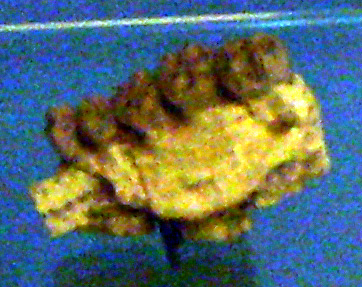- Samburupithecus
Taxobox | name = "Samburupithecus"
fossil_range = lateMiocene

image_width = 250px
image_caption = "Samburupithecus kiptalami" fossil,Muséum national d'histoire naturelle , Paris
regnum =Animal ia
phylum = Chordata
classis =Mammal ia
ordo =Primates
superfamilia =Hominoidea
familia =Hominidae
subfamilia = "incertae sedis "
genus = †"Samburupithecus"
species = †"S. kiptalami"
binomial = †"Samburupithecus kiptalami"
binomial_author = Ishida and Pickford,1997 "Samburupithecus" was a
primate that lived inKenya during the middle to lateMiocene . The one species in this genus, "Samburupithecus kiptalami", is known only from a maxilla fragment dated to 9.5 Ma discovered by Hidemi Ishida and Martin Pickford in 1997. "Samburupithecus" was approximately 60 kg and was most likely a frugivorus terrestrial quadruped (Fleagle, 1999). Paleoenvironmental reconstructions indicate that "Samburupithecus" most likely lived in a wooded habitat surrounded bysavannah (Tsujikawa, 2005).Defining cranial traits of this genus include low, broad zygomatics, straight
alveolar process and largemaxillary sinus . Defining dental traits include three-rootedpremolars , thickenamel and buonodont cusps (Ward, 2002). Unlike many other Miocene hominoids, "Samburupithecus" has teeth that are elongated from front to back. This feature links the taxon to gorillas, chimpanzees and hominins, but its relationships within thisclade are presently unknown (Fleagle, 1999).See also
*
List of fossil sites "(with link directory)"
*List of hominina (hominid) fossils "(with images)"References
* Fleagle, J.F. (1999) "Primate Adaptation and Evolution". Elsevier Academic Press. ISBN 978-0122603419
* Tsujikawa, Hiroshi. "Palaeoenvironment of Samburupithecus Based on its Associated Fauna" African Study Monographs, Suppl., 32: 51-62 http://jambo.africa.kyoto-u.ac.jp/kiroku/asm_suppl/abstracts/pdf/ASM_s32/51-62.pdf
* Ward, S.C. and Duren, D.L. (2002). "The Primate Fossil Record". Cambridge University Press. ISBN 978-0521663151
* [http://www.helsinki.fi/~mhaaramo/metazoa/deuterostoma/chordata/synapsida/eutheria/primates/hominoidea/hominidae_2.html Mikko's Phylogeny archives]
Wikimedia Foundation. 2010.
